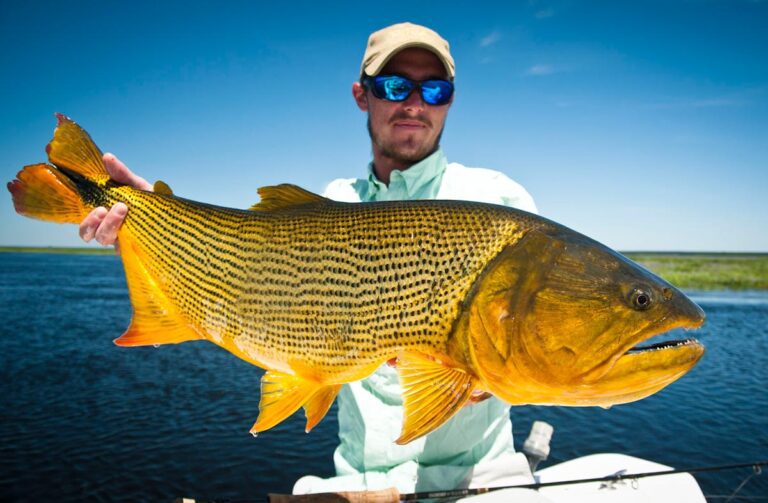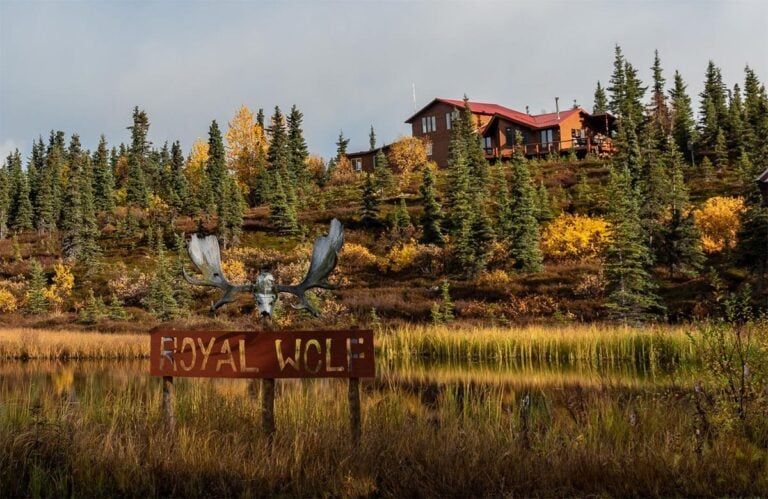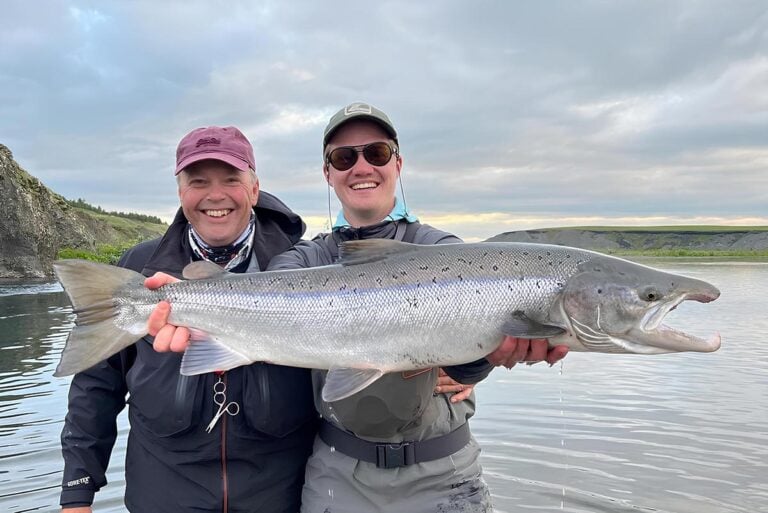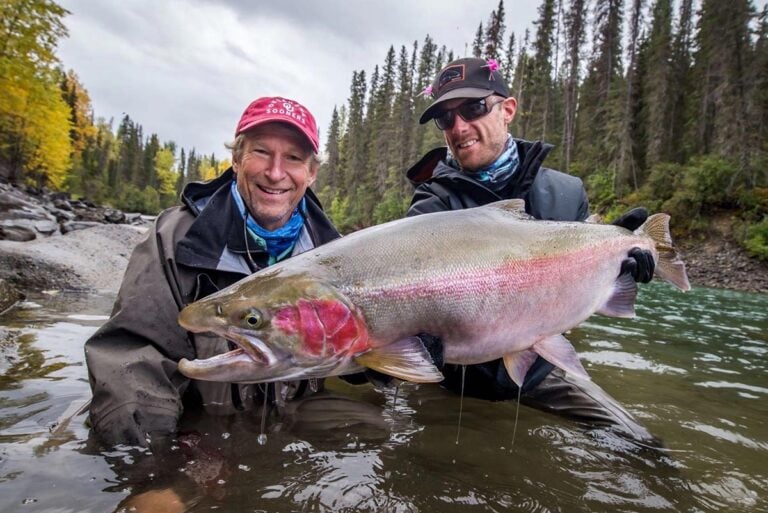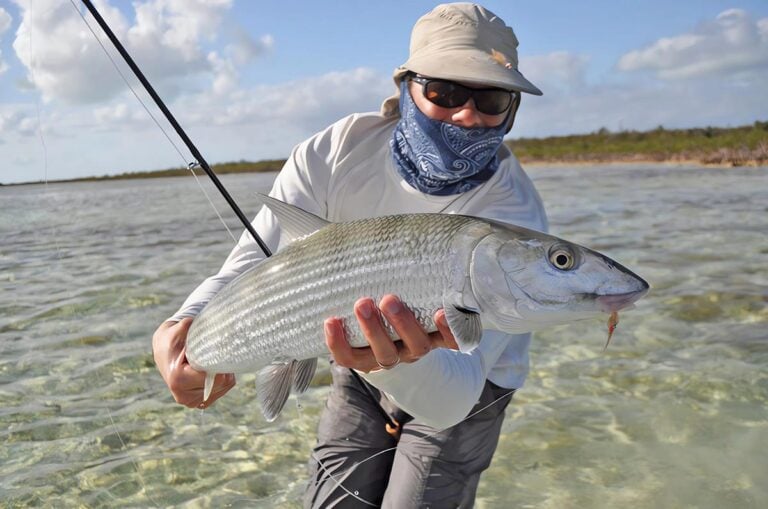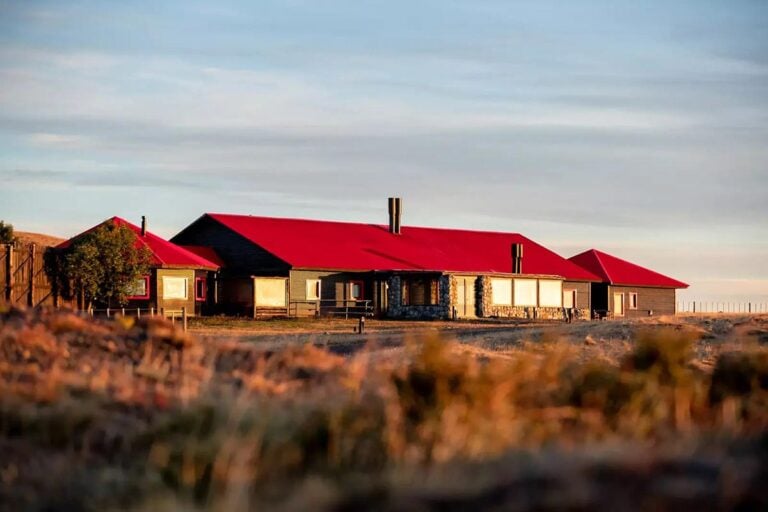From the windswept steppe near Esquel to the glacier-fed channels of Tierra del Fuego, Argentinian Patagonia offers a spread of trout water that rivals anywhere in the world. The draw isn’t just the numbers or the size—it’s the variety of systems and the precision with which you can tailor a trip.
Among the top Argentina fly fishing trips are those that combine multiple lodges and regions, allowing anglers to experience the country’s full range of freshwater environments.
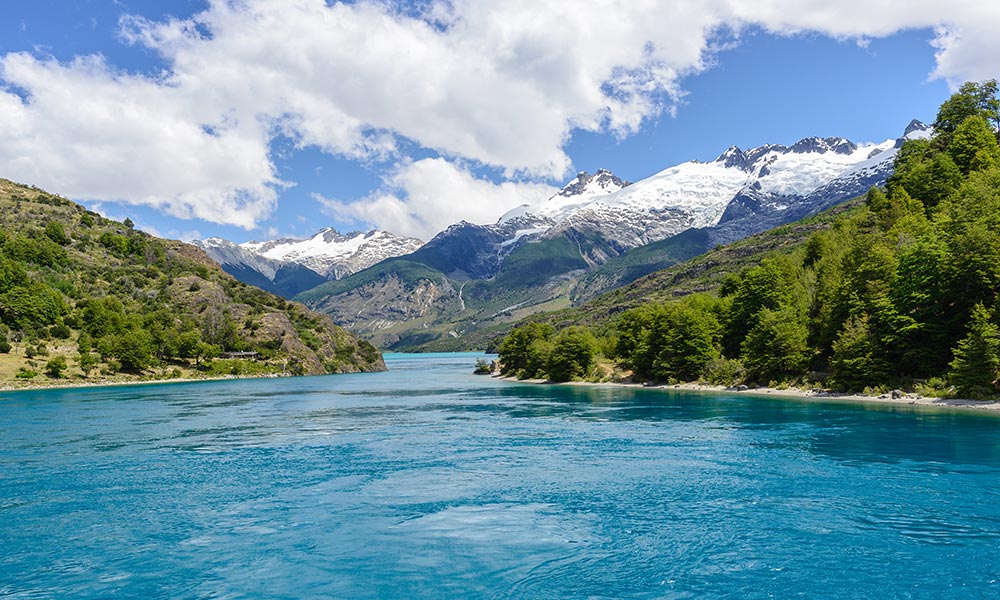
For example, a single week here might mean sight-casting to browns in the spring creeks outside Trevelin, working streamer patterns through the deep runs of the Río Limay, and then fly fishing for sea-run brown trout in the tidal reaches of the Río Grande.
For traveling fishermen accustomed to British Columbia steelhead lodges, Alaskan fishing trips, or New Zealand backcountry rivers, Patagonia delivers that same frontier feel—but with an accessible lodge network, high-standard guiding, and the ability to fish multiple, distinct watersheds in a single itinerary.
Patagonia’s Fly Fishing Regions
Patagonia is vast, spanning Neuquén, Río Negro, Chubut, Santa Cruz, and Tierra del Fuego provinces. Within this expanse are distinct subregions, each with their own seasonal patterns, target species, and logistical considerations.
Northern Patagonia (Neuquén and Río Negro)

Anchored by San Martín de los Andes and Bariloche, Northern Patagonia blends Andean lake systems with famous tailwaters. The Río Malleo below Lago Tromen is a classic dry-fly fishery, with prolific hatches and easy wading. The Collón Curá fishes big—wide gravel bars, swinging runs, and long casts rewarded with solid browns and rainbows. The Río Limay Superior drains Lago Nahuel Huapi, producing trophy-sized fish that migrate in and out of the lake.
Central Patagonia (Chubut)

Centered around Esquel and Trevelin, this area offers access to Los Alerces National Park—home to the crystal-clear Río Rivadavia, the emerald Río Arrayanes, and the Río Frey. Spring creeks like the Nant y Fall give technical fishing with consistent mayfly and caddis hatches.
Southern Patagonia (Santa Cruz)

Sparse in population but loaded with water, the Santa Cruz River itself is a massive glacial system famous for steelhead-like sea-run rainbows. Outfitter access here is more limited, so planning well ahead is essential.
Tierra del Fuego
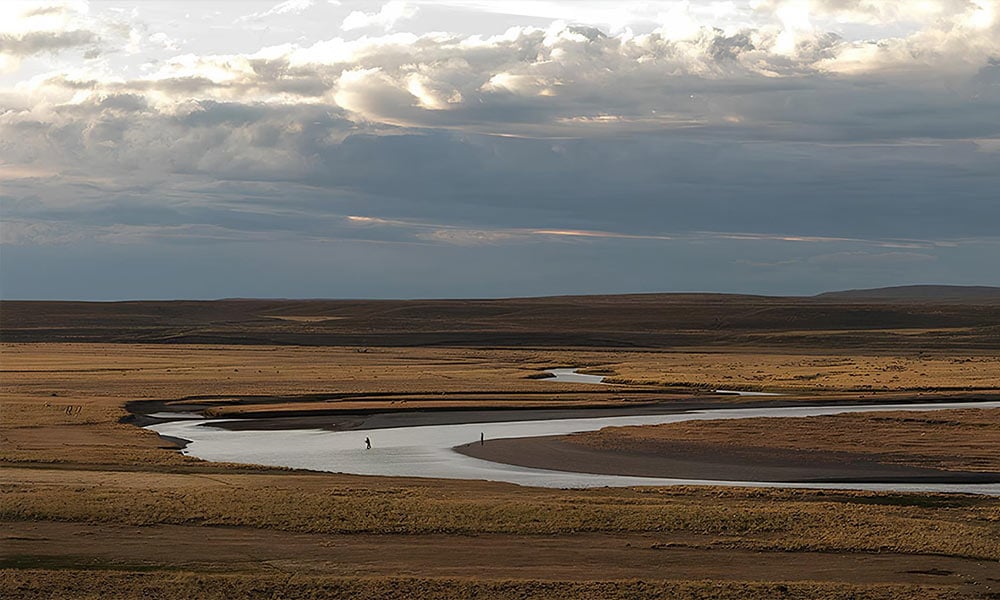
At South America’s southern tip, anglers target some of the world’s largest brown trout—sea-run fish that can approach 20 pounds—returning to remote rivers like the Río Grande. Kau Tapen Lodge and Villa María Lodge focus on swinging flies for these powerful migrators in demanding conditions, with evenings marked by gourmet meals, riverside saunas, and fireside relaxation.
Target Species and Techniques
While wild brown and rainbow trout fishing are the mainstay of Patagonia’s inland scene—and the reason most visiting fishermen plan their trips here—the waters hold more variety than many expect. Depending on where you base your stay, and how much you’re willing to travel within your itinerary, it’s possible to encounter other species that add some additional variety and challenge.
From the migratory power of sea-run brown trout in Tierra del Fuego to the limited-range landlocked salmon of the Corcovado (and even golden dorado for those combining a northern extension) each offers its own techniques and seasonal considerations:
Resident Brown & Rainbow Trout
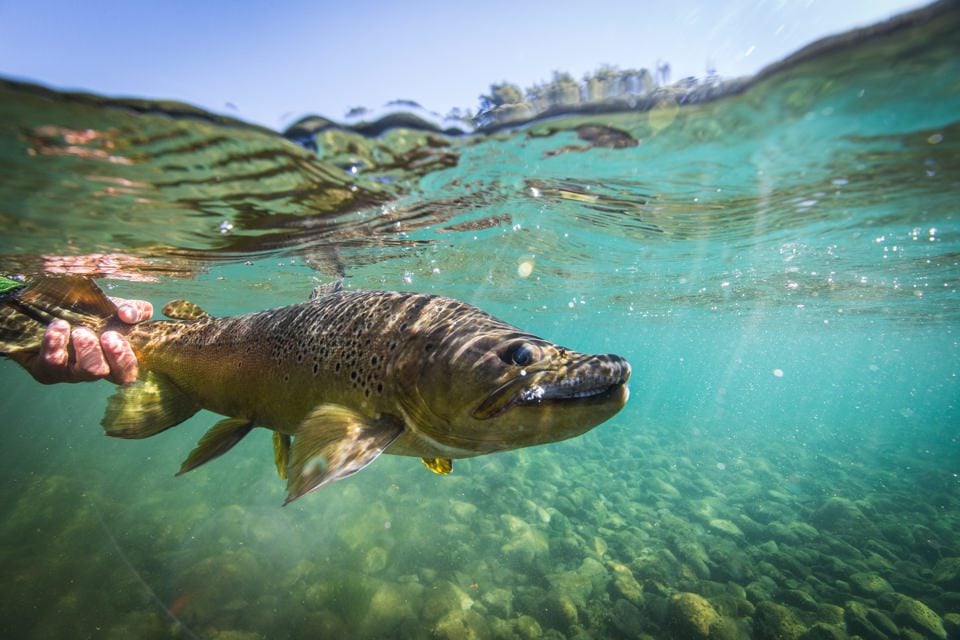
Found in rivers like the Río Malleo, Río Futaleufú, and Río Chimehuin. Trout are the backbone of Patagonia’s freshwater scene, thriving in cold, oxygen-rich flows where insect hatches can be both dense and predictable.
Browns here often grow heavy on a diet of pancora crabs and minnows, while rainbows stay strong and acrobatic, feeding aggressively through most of the season.
On larger rivers like the Chimehuin or Futaleufú, they hold in deeper seams and behind boulders, ready to pounce on a well-placed terrestrial or attractor dry.
Sea-Run Brown Trout
Concentrated in Tierra del Fuego’s Río Grande and Río Gallegos. These ocean-feeding browns return to freshwater in peak condition, carrying both the bulk and the fight of a true migratory predator. They can top 20 pounds, with thick shoulders and a tendency to bulldog deep or erupt into powerful runs across the current.
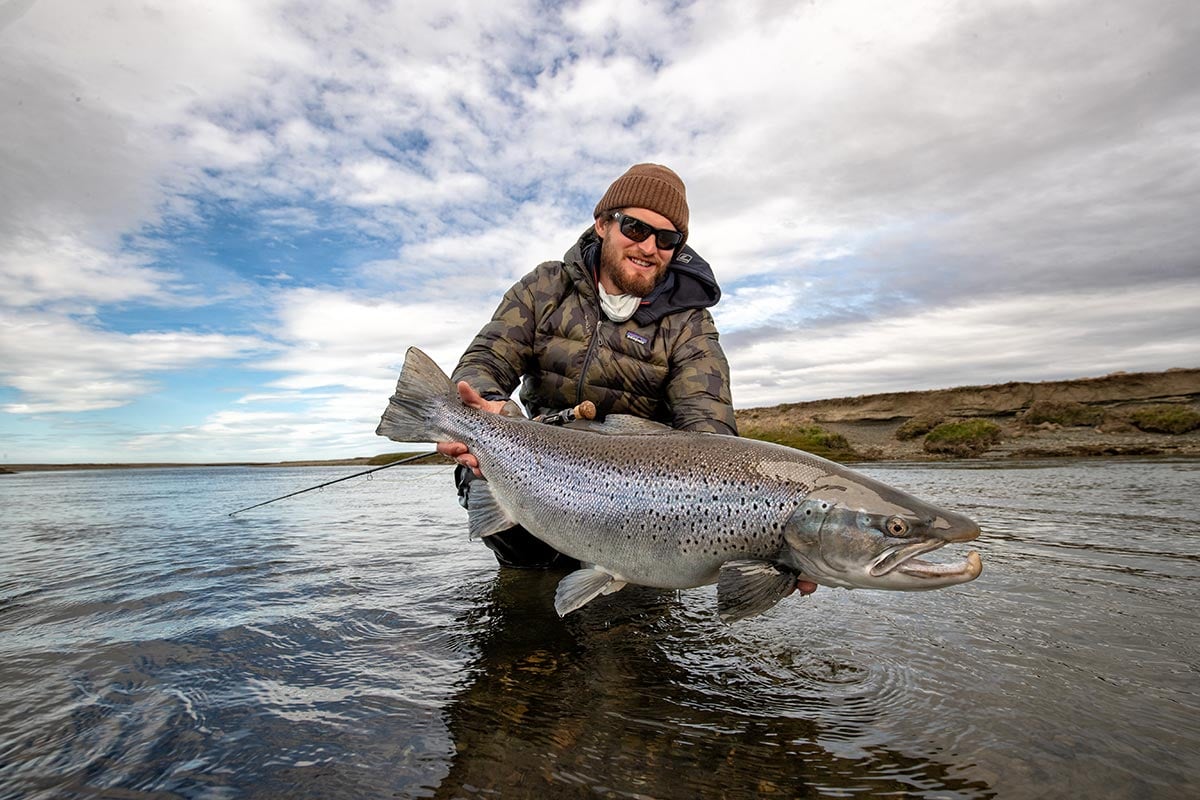
Each fish is a prize, often earned after long hours of swinging leeches or intruder-style flies through prime holding water. Their strikes can be subtle or downright violent, but once hooked, they test every knot, every inch of backing, and the angler’s patience in windswept, unforgiving conditions.
Landlocked Salmon
While most anglers travel to Patagonia for its wild browns and rainbows, a few rivers hold an additional surprise—landlocked salmon. They are present in systems like the Corcovado River, offering an Atlantic salmon-like fight. They share the same streamlined build and raw strength as their sea-run relatives, using deep pools, strong currents, and structure to their advantage. They’ll hammer swung streamers, chase a skated dry, or take a drifting nymph in the right conditions. Once hooked, they’re all muscle—long, sustained runs, powerful head shakes, and the occasional leap.
Their limited range in Patagonia makes them a unique catch, and their willingness to fight to the last yard of line leaves a lasting impression on those lucky enough to connect. But for those fishing the right system, connecting with one can be a memorable highlight alongside South America’s best trout fishing.
Golden Dorado
While not technically Patagonia, anglers often tack on a northern extension to Corrientes Province’s Paraná River to chase dorado after a trout week.
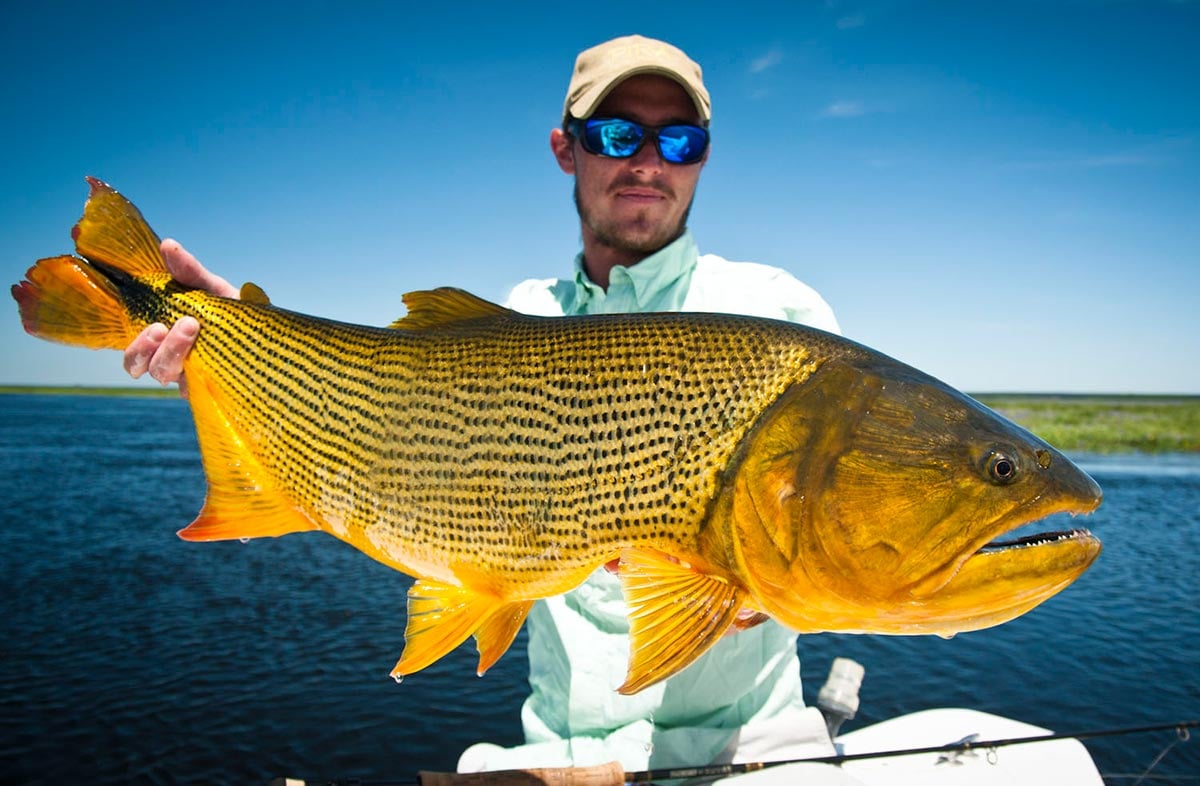
Golden dorado are among the most aggressive freshwater predators you can target, and Argentina’s Paraná River and Iberá Marshlands stand at the top of the list for world-class encounters.
Lodges like Pirá Lodge, Karandá Lodge, and Suindá Lodge combine prime access to remote, productive water with air-conditioned comfort and guides who know these jungle systems inside and out.
River-by-River: Where the Fishing Happens
Northern Patagonia (Neuquén & Río Negro)
Río Chimehuin—Junín de los AndesClassic Andean freestone with a tailwater-like rhythm near Lago Huechulafquen. The channels below the Boca (lake outlet) are famous for migratory browns. Summer brings caddis and beetle fishing along willow-lined banks; autumn streamer sessions can move truly large fish.
Río Malleo—Parque Nacional Lanín
A dry-fly laboratory flowing off Lago Tromen below Volcán Lanín. Upper beats feature riffle‑run water ideal for long leaders and #14–#18 mayflies. The lower meadows fish well with terrestrials and small hoppers in January–February. Easy wading, high visibility, and consistent hatches make it a must.
Río Collón Curá—Piedra del Águila corridor
Broad, brawling water with long gravel bars and mid‑river ledges. Productive for nymphing and streamers; on windy afternoons, foam beetles shine along edges and mid‑river buckets. Often floated to cover mileage between La Rinconada and Paso Chacabuco.
Río Limay (Superior & Medio)—Nahuel Huapi to Piedra del Águila
A powerhouse system dropping from Lago Nahuel Huapi near Bariloche. The Limay Superior holds migratory browns that slide in and out of the lake; the Medio gains volume and structure. Sink‑tips and streamer patterns that mimic pancora crabs are staples, with sight‑casting opportunities on bright days.
Río Traful
Short, cold, and cobalt-clear, linking Lago Traful to the Limay. Known for selective browns and occasional landlocked Atlantics. Long leaders, stealth, and sparse dries or small streamers over boulder gardens.
Río Caleufú—Lago Falkner to Collón Curá
Braided side channels, woody debris, and cutbanks. Great hopper water in midsummer, with steady action for strong rainbows and opportunistic browns. A favorite “variety day” when winds push you off the big lakes.
Pichi Leufú & Filo Hua Hum
Smaller, intimate options when larger rivers run high. Expect pocketwater nymphing transitioning to beetles and ants as flows drop.
Lakes: Nahuel Huapi, Huechulafquen, Tromen, Traful
Even if you’re a river purist, the drop‑offs, weed lines, and inlets on these lakes can produce with intermediate lines and suspending streamers. Morning and evening light windows are prime.
Central Patagonia (Chubut)
Los Alerces National Park—Esquel & Trevelin hub
This park concentrates some of the clearest water in South America.
• Río Rivadavia – Spring‑creek clarity with sight‑fishing to browns and rainbows tucked against submerged timber and weedbeds. Small dries and unweighted nymphs excel; a stealth approach is mandatory.
• Río Arrayanes – Cold, emerald channel below Lago Verde with structure that fishes well to swung soft hackles and small streamers.
• Río Frey – Connective water between lakes Rivadavia, Menéndez, and Futalaufquen; classic float days that mix dries and nymphs.
• Lago Rivadavia, Lago Verde, Lago Futalaufquen, Lago Menéndez – Gin‑clear edges and drop‑offs; work the windward side when terrestrials blow in.
Nant y Fall—Trevelin spring‑creek country
Meadows, cutbanks, clear heads and tails. Mid‑summer terrestrials (#12 beetles, small hoppers) and late‑day caddis. Technical but generous if you stay low and present first cast clean.
Arroyo Pescado—Esquel outskirts
Narrow, weedy lanes with spooky fish. Try 5X–6X, #16–#20 emergers, and cross‑stream reach casts. A perfect “light tackle” day in a multi‑river itinerary.
Río Corcovado—Alto Río Senguer basin
A larger freestone linking lakes and foothill valleys, with chances at stout browns and resident rainbows; certain reaches hold landlocked salmon. Streamers against seam lines in the morning, then transitions to dries.
Río Futaleufú (upper Argentine reaches)
Powerful, deep teal water exiting Embalse Amutui Quimey toward the Chilean border. Productive from rafts with sink‑tips; bankside pockets can produce surprise surface eats in evening shade.
Southern Patagonia (Santa Cruz)
Río Gallegos—Estuary to steppe
A low‑gradient, peat‑tinged river famous for sea‑run browns. Long, even glides and peat cutbanks favor swung flies and patient grid‑covering. Wind is a factor; 7–8‑weight setups with Scandi or Skagit heads are common.
Río Santa Cruz—Glacier‑blue mainstem
Known for anadromous (sea‑run) rainbows—steelhead‑like fish that enter from the Atlantic. Wide water and heavy currents reward sink‑tips and weighted intruders. Logistics require good local planning due to access and flow management.
Río Chico & Río Deseado (select reaches)
Smaller options in the province; windows can be short but rewarding when conditions align.
Tierra del Fuego (Isla Grande)
Río Grande—Tolhuin to the estuary
The world standard for sea‑run browns. Private beats rotate two rods per guide across upper, middle, and lower sections, targeting cutbanks, tailouts, and laminar glides. Productive flies include leeches, rubber‑leg nymphs, and small copper/black streamers; in low light, larger profiles wake up the biggest fish.
Río Irigoyen—Atlantic forest shelter
Narrower, woodier, and more sheltered from wind than the Grande. Perfect for short, accurate casts with sink‑tips, and ideal when gales shut down open steppe water. Tides influence lower beats; time your sessions to moving water.
Logistics: Getting There and Moving Between Regions
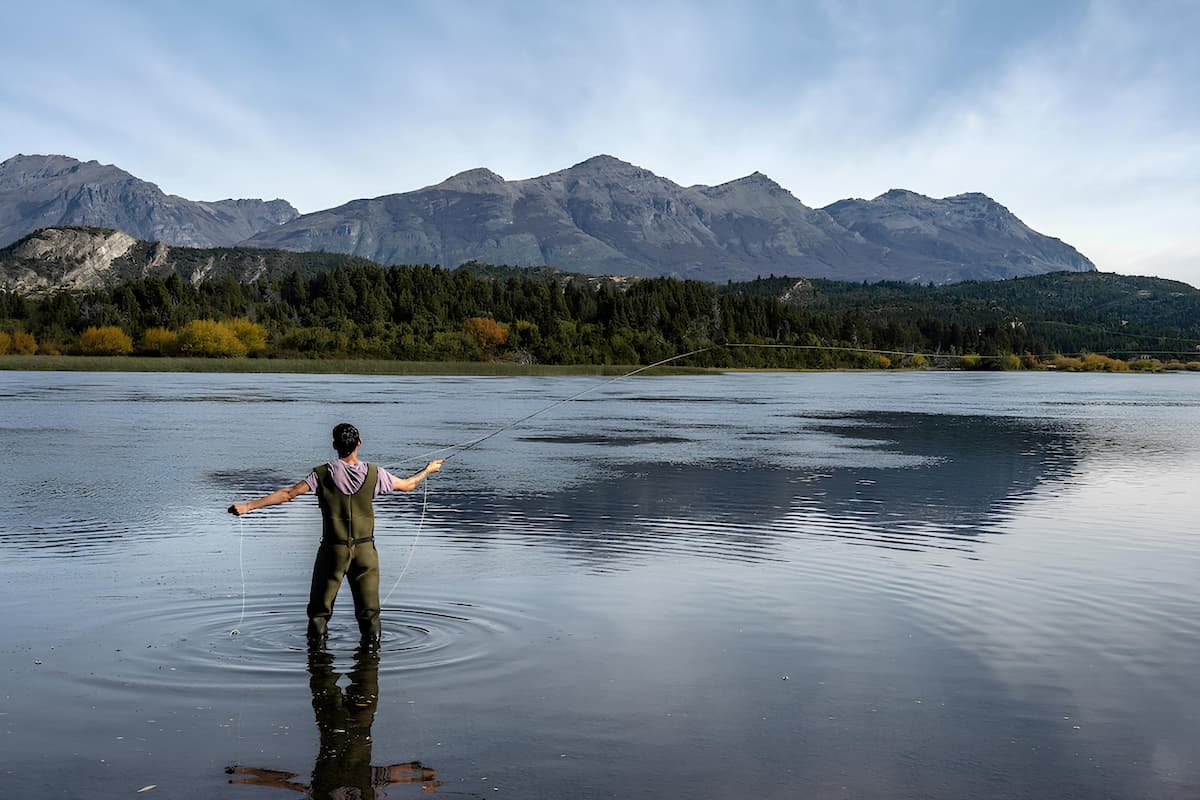
Most international travelers enter Argentina via Buenos Aires (Ezeiza International Airport, EZE). From there, domestic flights connect directly to the key gateways for each fishing region. For Northern Patagonia, San Martín de los Andes (Chapelco Airport, CPC) and Bariloche (Teniente Luis Candelaria Airport, BRC) are the main arrivals. For Central Patagonia, anglers typically fly into Esquel Airport (EQS). Reaching Tierra del Fuego means a flight to Ushuaia (Malvinas Argentinas International Airport, USH) or Río Grande (Hermes Quijada International Airport, RGA), depending on the lodge’s transfer arrangements.
Once in-region, lodge transfers are usually handled in private 4×4 vehicles or high-capacity SUVs, as many rivers lie beyond paved routes. Drives from Bariloche to the Río Malleo can take three hours, while the trip from Esquel to Los Alerces National Park is under an hour. In Tierra del Fuego, the road network is sparse, but most prime Río Grande beats are within 45 minutes of the main estancias.
Combining northern and southern programs requires careful sequencing. An efficient approach is to fish Patagonia Norte first, then return to Buenos Aires for an overnight before catching a morning flight south to Río Grande. Some outfitters coordinate private charters between Bariloche or Esquel and Río Grande, cutting travel time and avoiding layovers in Buenos Aires entirely.
Travel Documents and Entry Requirements
U.S., Canadian, EU, and Australian passport holders do not require a visa for stays of up to 90 days. Passports must be valid for at least 6 months beyond the departure date. Import regulations allow travelers to bring personal fishing gear duty-free, but waders and boots must be thoroughly cleaned and dried—inspectors at airports in Bariloche and Ushuaia are increasingly vigilant about preventing the spread of aquatic invasive species like didymo.
Permits, Access, and On‑Water Etiquette
Fishing Licenses
Argentina issues sportfishing licenses by province. If you move from Neuquén to Chubut to Tierra del Fuego, you’ll need coverage for each jurisdiction. Lodges typically arrange permits on arrival; independent anglers may obtain them in Bariloche, San Martín de los Andes, Esquel, Río Gallegos, or Río Grande before hitting the water.
Beat Rotation & Pressure
On marquee rivers (especially the Río Grande), respect beat assignments and rotation timing. On public access reaches (Malleo, Chimehuin), give other fishermen space—long runs fish best when you keep moving.
Seasonal Patterns and Timing Your Trip

Patagonia’s fly fishing calendar runs roughly from November through April, with each month offering distinct conditions. Choosing when to go is as much about the rivers you want to fish as it is about weather, water clarity, and hatch cycles.
Individual lodges also operate on their own fishing seasons within that window, timed to match the peak activity on their home waters. For example, a Río Grande lodge might open in early January to coincide with the arrival of the first strong runs of sea-run browns, while a northern Patagonia trout lodge could start its season in November when spring creeks and freestones settle into clear, fishable flows.
Early Season (November–December)
Snowmelt has mostly subsided in the north, and the spring creeks are in prime shape. The Río Malleo’s caddis hatches can be phenomenal, and the Río Limay sees migratory browns pushing upstream from Nahuel Huapi. In Chubut, the Río Rivadavia runs full but clear, with fish looking up for beetles and early mayflies. This is also when the Río Grande opens in Tierra del Fuego, with fresh sea-run browns beginning their upstream migration.
Mid-Season (January–February)
The height of summer brings consistent dry-fly fishing across Neuquén, Río Negro, and Chubut. Terrestrials dominate—beetles, hoppers, and ants are staples on rivers like the Nant y Fall and Collón Curá. Lodge programs often rotate anglers between smaller creeks for technical sight-fishing and larger floatable rivers for numbers and size. In Tierra del Fuego, this is peak time for big, chrome-bright sea-run browns, with both single- and double-handed setups seeing action.
Late Season (March–April)
Cooling temperatures trigger pre-spawn aggression in large browns, especially in the Limay and Chimehuin. Sea-run browns in the Río Grande and Río Gallegos are at their heaviest, having spent weeks feeding in the river. Water levels typically drop, and clarity improves, making for excellent sight-casting opportunities. In Los Alerces National Park, the Rivadavia and Arrayanes remain clear, with autumn colors framing the fishing.
Packing Strategy for Patagonia Fly Fishing
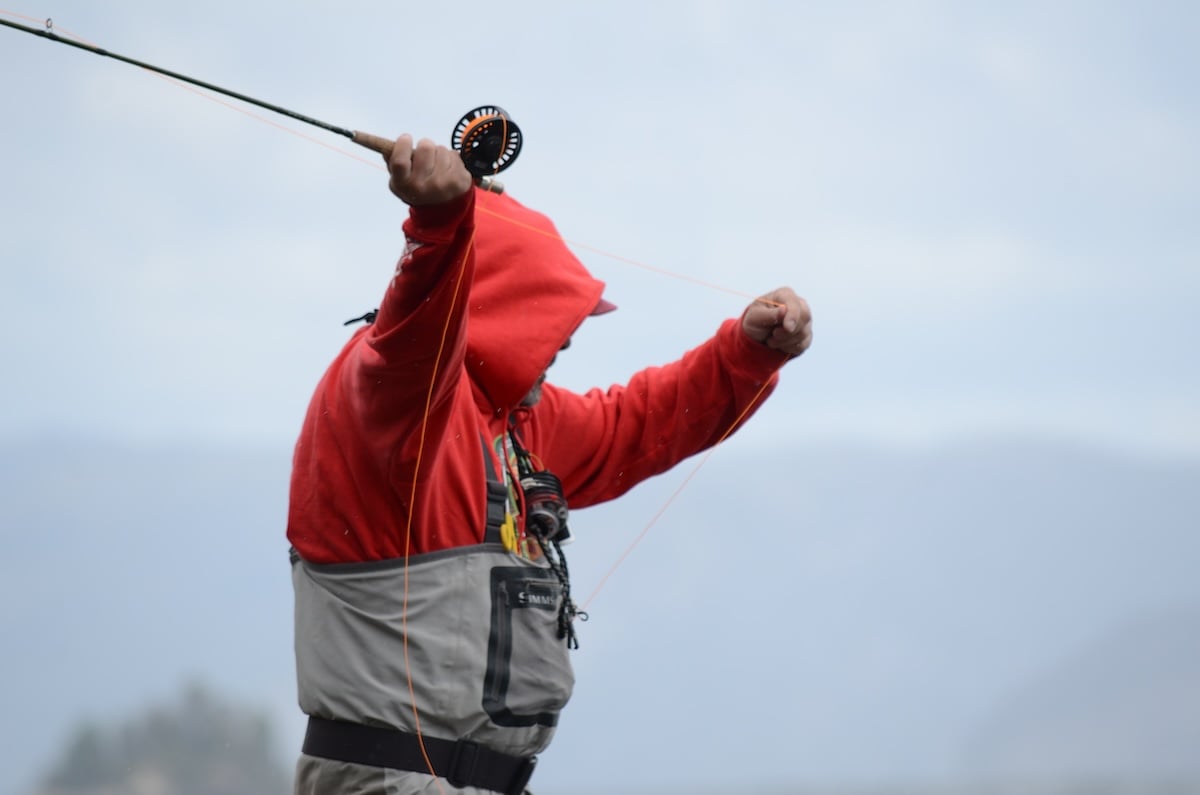
Seasonal variability and rapid weather changes demand a layered clothing system. Even in mid-summer, mornings on the Río Limay or Río Grande can start near freezing, with strong afternoon sun requiring lightweight shirts and sun protection. Breathable chest waders and a quality rain jacket are critical, especially for fly fishing in Los Alerces’ temperate rainforests or Tierra del Fuego’s wind-swept valleys.
Rod tubes should be travel-rated, with at least two backup setups to cover varying river sizes and species. A mix of floating and sink-tip lines is essential—floating lines for dry-fly work on the Malleo or Nant y Fall, sink tips for streamer fishing the Limay, and intermediate tips for swinging through deep pools on the Río Grande.
Techniques, Tackle, and Flies by Water Type
Spring Creeks (Nant y Fall, Arroyo Pescado, Rivadavia edges)
4–5‑weights; long leaders (12–15 ft) to 5X/6X; CDC emergers, #16–#20 mayflies, #14–#16 caddis, ants and beetles. Unweighted nymphs and lightly dressed soft hackles for spooky fish.
Freestones & Tailwaters (Chimehuin, Malleo, Collón Curá, Limay)
5–6‑weights; floating lines for dries, with a spare spool carrying a Type 3–6 sink‑tip for streamers. Patterns: foam terrestrials, mini‑dungeons, sparse sculpins, and pancora imitations. Nymph rigs with stonefly + mayfly droppers handle midday lulls.
Sea‑Run Browns (Río Grande, Gallegos, Irigoyen)
7–8‑weights; Scandi/Skagit heads with interchangeable tips (T‑8 to T‑14). Flies: leeches, zonkers, rubber‑leg bugs, copper‑wire nymphs, and small black streamers for clear water. Think slow swings, hang‑downs, and methodical step‑downs.
Stillwaters (Nahuel Huapi, Futalaufquen, Rivadavia/Verde margins)
6‑weights with intermediate lines; suspend small streamers over weed lines; work inlets where creeks deliver food. Damsel/dragon nymphs and baitfish patterns match what’s cruising the edges.
Gear Matrix for Multi-Region Patagonia Trips
| Water Type & Region | Rod Weight | Lines | Leaders/Tippet | Key Flies |
| Spring Creeks (Nant y Fall, Arroyo Pescado, upper Rivadavia) | 4–5 wt | WF floating | 12–15 ft, 5X–6X | CDC emergers, small mayflies (#16–#20), caddis (#14–#16), ants/beetles (#12–#14) |
| Medium Freestones & Tailwaters (Malleo, Chimehuin, Collón Curá) | 5–6 wt | WF floating + spare sink-tip (Type 3–6) | 9–12 ft, 3X–5X | Foam terrestrials, mini-dungeons, sculpins, pancora crab patterns |
| Big Rivers (Limay Superior, lower Chimehuin) | 6 wt | WF floating + sink-tip | 9 ft, 2X–4X | Weighted streamers, large beetles, stonefly nymph rigs |
| Sea-Run Browns (Río Grande, Río Gallegos, Río Irigoyen) | 7–8 wt | Scandi/Skagit heads with tips (T-8 to T-14) | 9–10 ft, 0X–2X | Leeches, rubber-leg nymphs, zonkers, copper/black streamers |
| Stillwaters (Nahuel Huapi, Futalaufquen, Verde margins) | 6 wt | Intermediate | 9–12 ft, 2X–4X | Damsel/dragon nymphs, baitfish streamers, suspending patterns |
Lodges
For trout fly fishing, Patagonia sits firmly on the bucket list, with cold, clear waters holding browns, rainbows, and brook trout in abundance. Premier fly fishing lodges in Patagonia like PRG’s Tipiliuke Lodge, Tres Valles Lodge, and The River House provide exclusive access to private river stretches, luxurious accommodations, and chef-driven cuisine.
A typical Argentine Patagonia fly fishing lodge based itinerary balances variety with efficiency. For example, guests might fish the Río Malleo on day one, then float the Limay Superior the next, switching to a spring creek like the Arroyo Pescado midweek before a long drift down the Collón Curá. In Chubut, it’s common to combine a day on the Rivadavia with a half-day on Lago Verde, using rafts to access drop-offs and weedbeds unreachable from shore.
Tierra del Fuego fly fishing lodge programs are typically more regimented, with the Río Grande divided into private beats. Estancias may provide 4×4 access to remote reaches, minimizing walking in the relentless wind.
Anglers and their guide rotate between upper, middle, and lower sections, fishing morning and evening sessions to take advantage of low light and rested pools. Here, guests typically stay in renowned estancias such as Kau Tapen or Villa María, with private beats and a rotation system that ensures rested water—and evenings marked by gourmet meals, riverside saunas, and fireside relaxation.
Featured Lodges
Tipiluke Lodge
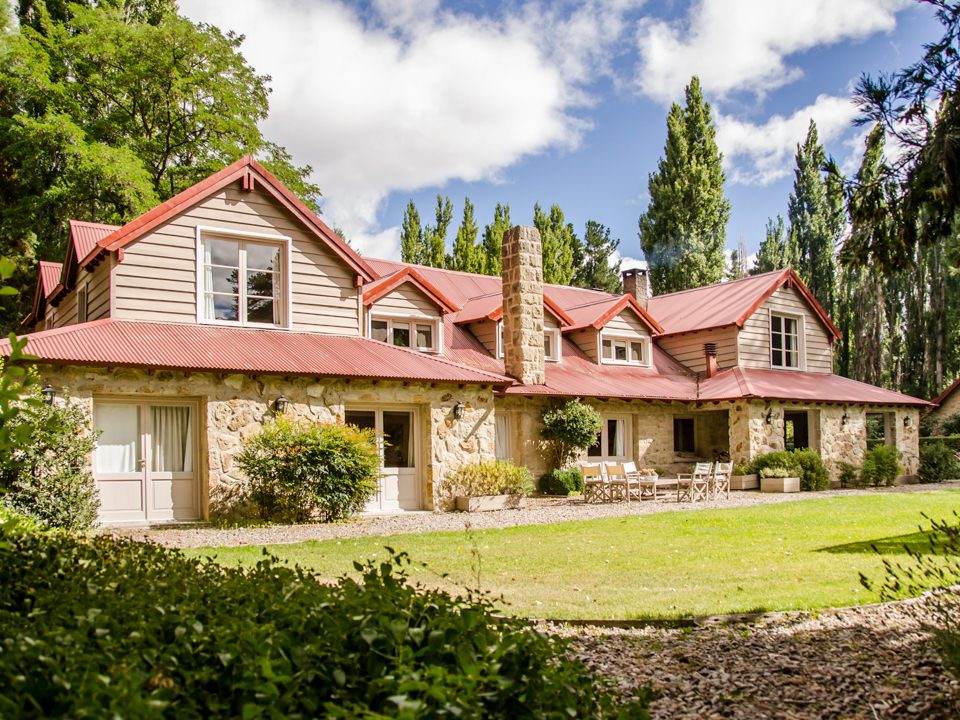
Tipiliuke Lodge is set in the Chimehuin River Valley of Neuquén Province, surrounded by some of northern Patagonia’s most productive trout water. With over 30 kilometers of private access to the Chimehuin and additional beats on the Quilquihue River and several spring creeks, the variety of fishing is a major draw.
Days can be spent wading clear freestone runs, drifting long pools, or working smaller, technical creeks with light tackle. The season here runs from November through May, with consistent opportunities for both browns and rainbows. Local guides know the nuances of each stretch, adjusting tactics from dry flies to nymphs or streamers depending on conditions and time of year.
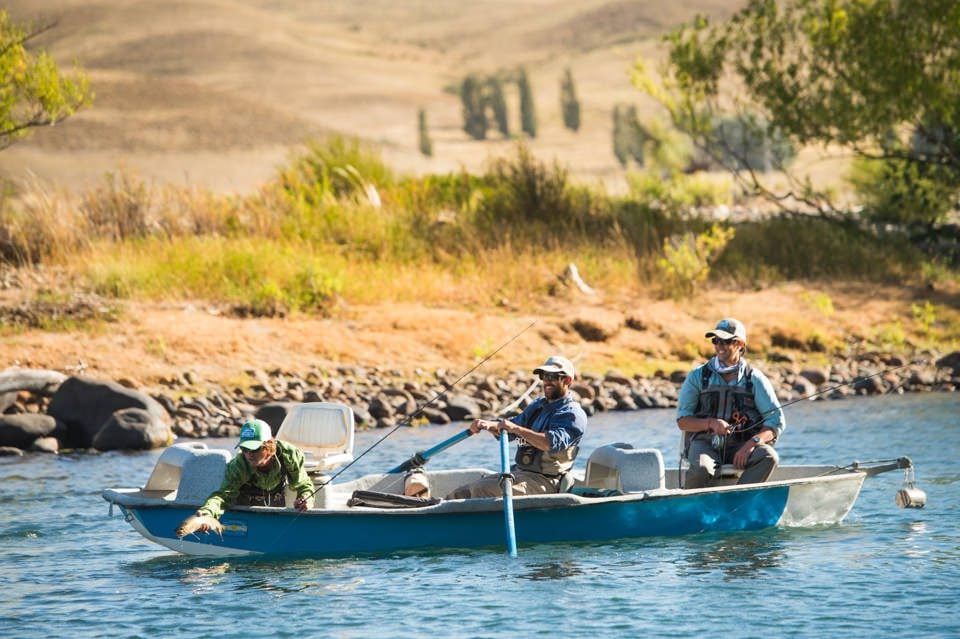
The lodge itself is designed for comfort in a remote setting, with eight guest rooms that have private bathrooms and mountain views. Common spaces include a living room with a stone fireplace, a bar, and a dining area serving meals made from locally sourced ingredients. After fishing, guests can make use of amenities like Wi-Fi or a hot tub, and evenings are often spent sharing the day’s highlights with fellow anglers. Its location, access, and small guest capacity make Tipiliuke a practical base for anglers wanting to focus on a diverse stretch of northern Patagonia’s trout water.
Tres Valles

Tres Valles Lodge sits in the remote Río Pico Valley of southern Chubut Province, surrounded by a mix of spring creeks, mountain rivers, and high-country lakes that see little pressure. Fishing here with Patagonia River Guides opens access to an unusually diverse range of water — from clear, technical streams where sight-casting to browns and rainbows is possible, to deeper pools and channels suited for streamer or nymph work.
The nearby lakes are a highlight, holding large, well-fed trout thanks to nutrient-rich waters and minimal angling competition. Each day’s program is shaped around conditions, seasonal insect activity, and guest preference, ensuring that techniques and locations change to match the most productive opportunities.

The lodge accommodates up to 10 guests in 5 suites, each with a private bathroom and a deck looking toward either Vilches Lake or the rugged Desnudo Mountain. Indoor spaces include two living rooms, a library, and a full bar, with fireplaces adding warmth in the evenings. Meals draw on local ingredients, with traditional Argentine asados featured alongside other regional dishes.
Outdoor decks offer a place to unwind after fishing, and Wi-Fi provides a link to the outside world without detracting from the remote feel. For anglers seeking both variety on the water and a comfortable base in one of Patagonia’s more isolated valleys, Tres Valles offers a setting that supports long days of fishing and quiet evenings in a dramatic landscape.
The River House
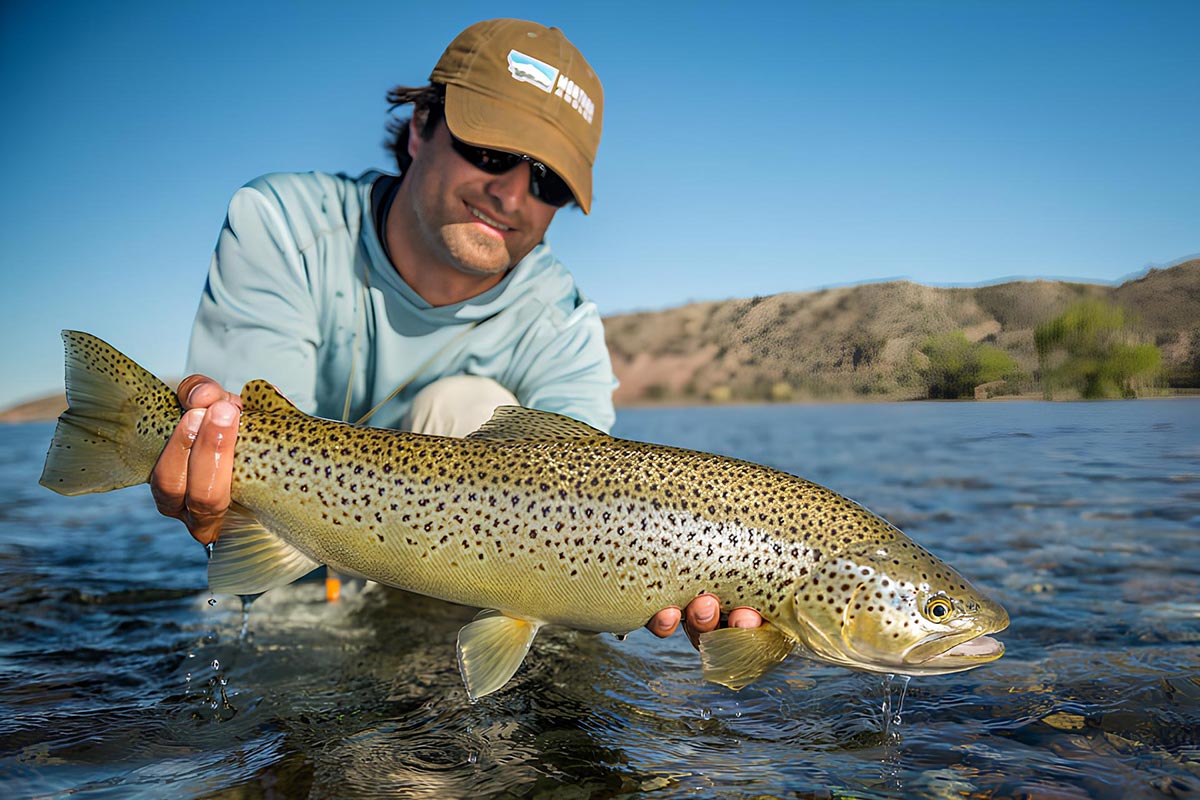
The River House sits directly on the banks of the Chimehuin River, one of northern Patagonia’s best-known trout fisheries. This clear, freestone river offers a mix of riffles, deep pools, and undercut banks that hold healthy populations of wild browns and rainbows. Guests can walk-and-wade from the property or float sections downstream, with PRG’s guides rotating beats to keep water fresh.
Early and late in the season, the Chimehuin is especially noted for its clarity and steady hatches, while mid-season brings consistent terrestrial action. For added variety, nearby spring creeks and small lakes provide alternative fishing options during multi-day stays, allowing anglers to adapt to changing conditions.
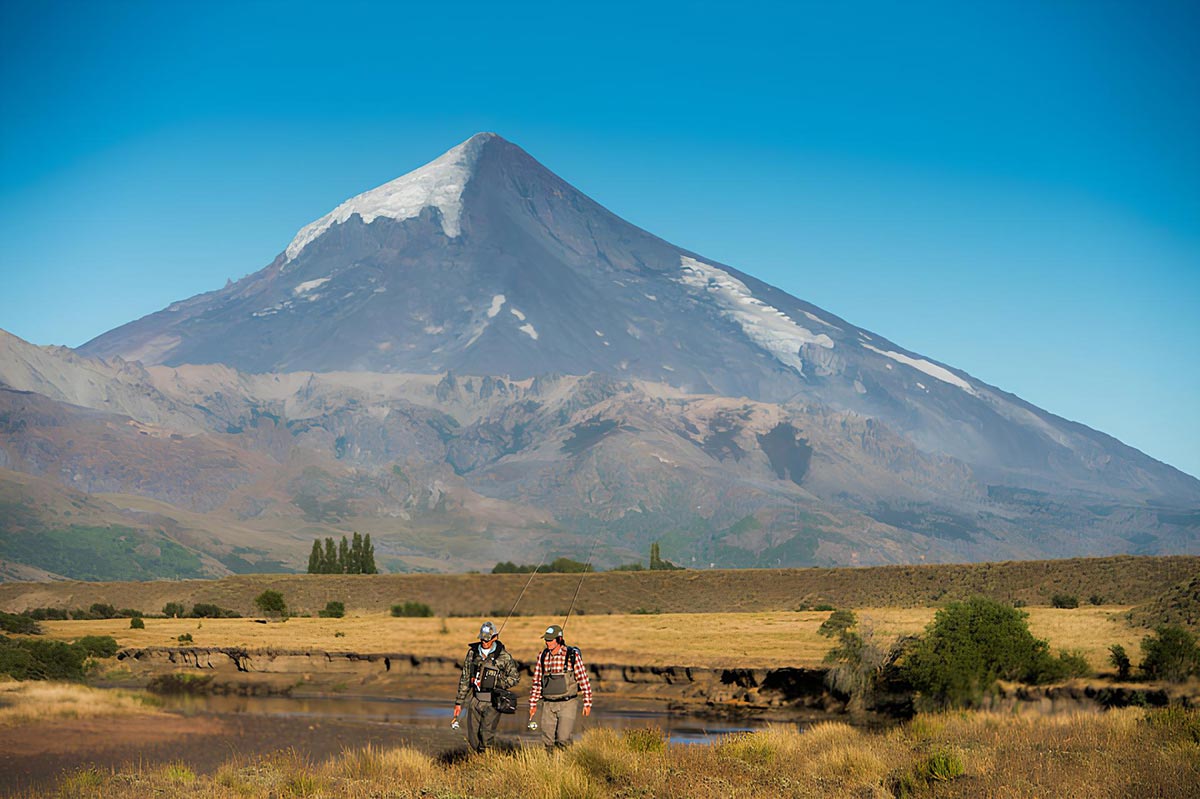
The lodge accommodates up to twelve guests in six suites, each with a private bathroom. Interiors combine Argentine country style with modern comforts, including a large living room anchored by a stone fireplace and a bar stocked with regional wines and spirits. Outside, landscaped gardens lead down toward the river, and mountain views frame the setting. Meals are prepared with local ingredients, and the staff can arrange excursions for those who want to explore beyond the water.
Positioned just outside Junín de los Andes, The River House serves as both a convenient base for focused fishing on the Chimehuin, and a comfortable stopover if you’re linking other Patagonia itineraries.
Kau Tapen
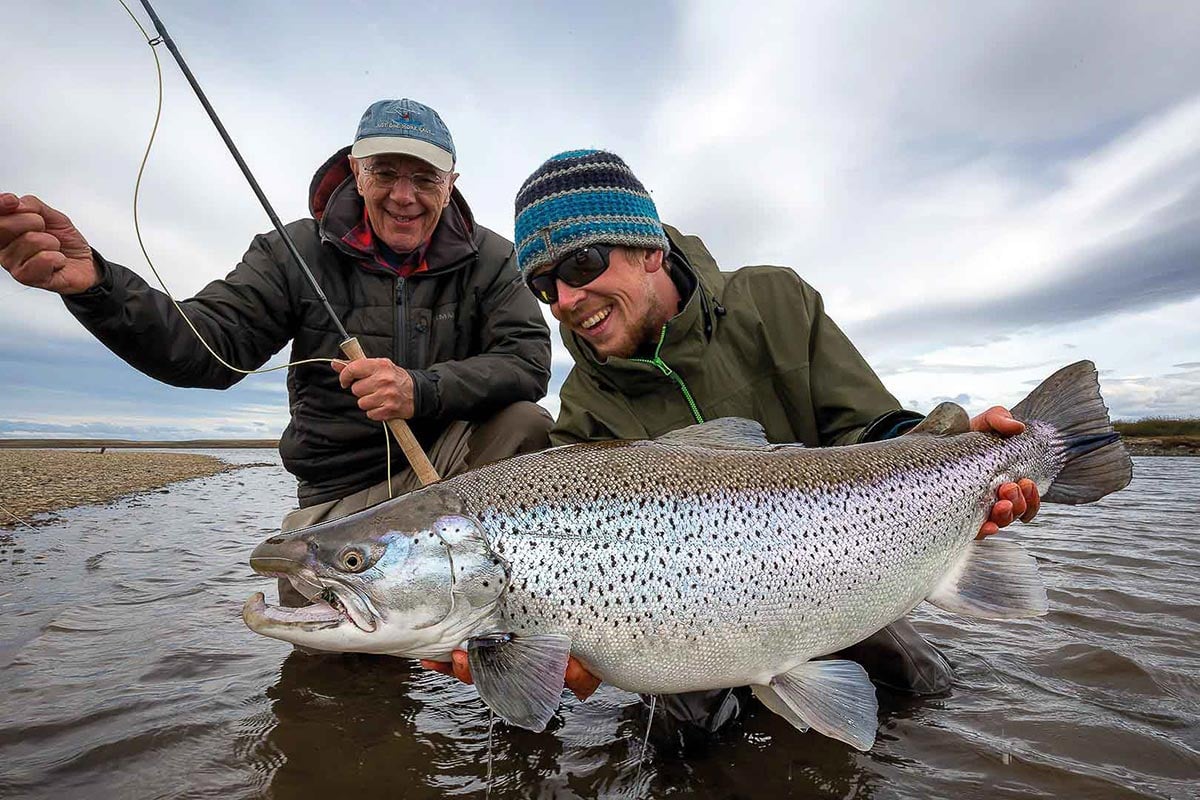
Kau Tapen Lodge sits on a prime stretch of the Río Grande in Tierra del Fuego, long recognized as one of the finest sea-run brown trout rivers in the world. With exclusive access to miles of private water, anglers can fish a variety of holding water, from broad, wind-swept runs to sheltered pools that demand precise presentation.
The trout here are famous for both size and power, and double-digit fish are a realistic expectation each week of the season. Local guides know each beat intimately, advising on fly choice, swing speed, and where the largest fish tend to hold under changing conditions. Days are split into morning and evening sessions to take advantage of prime light and fish movement, with time to rest and enjoy a midday meal at the lodge or streamside.
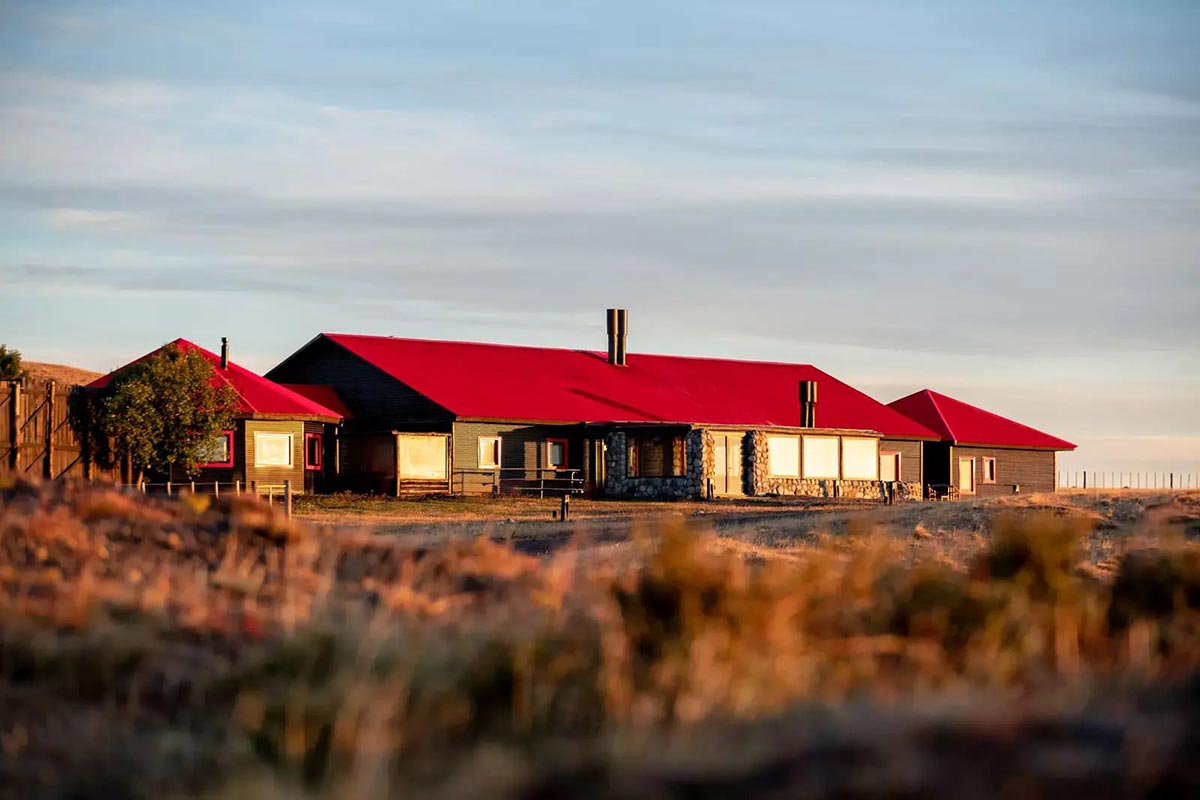
The lodge itself was the first established on the Río Grande, and it reflects decades of experience hosting traveling fishermen. Guests stay in comfortable, well-appointed rooms and have access to spaces for relaxing, drying gear, and sharing stories at day’s end. Evenings bring excellent meals complemented by Argentine wines, with the option to soak in a riverside hot tub before the next day’s fishing.
Whether you spend the week working the main stem of the Río Grande or exploring the smaller Río Menéndez, the combination of productive water, seasoned guides, and the remoteness of Tierra del Fuego offers a fishing trip that’s as rewarding for its setting as for its catch.
Villa Maria
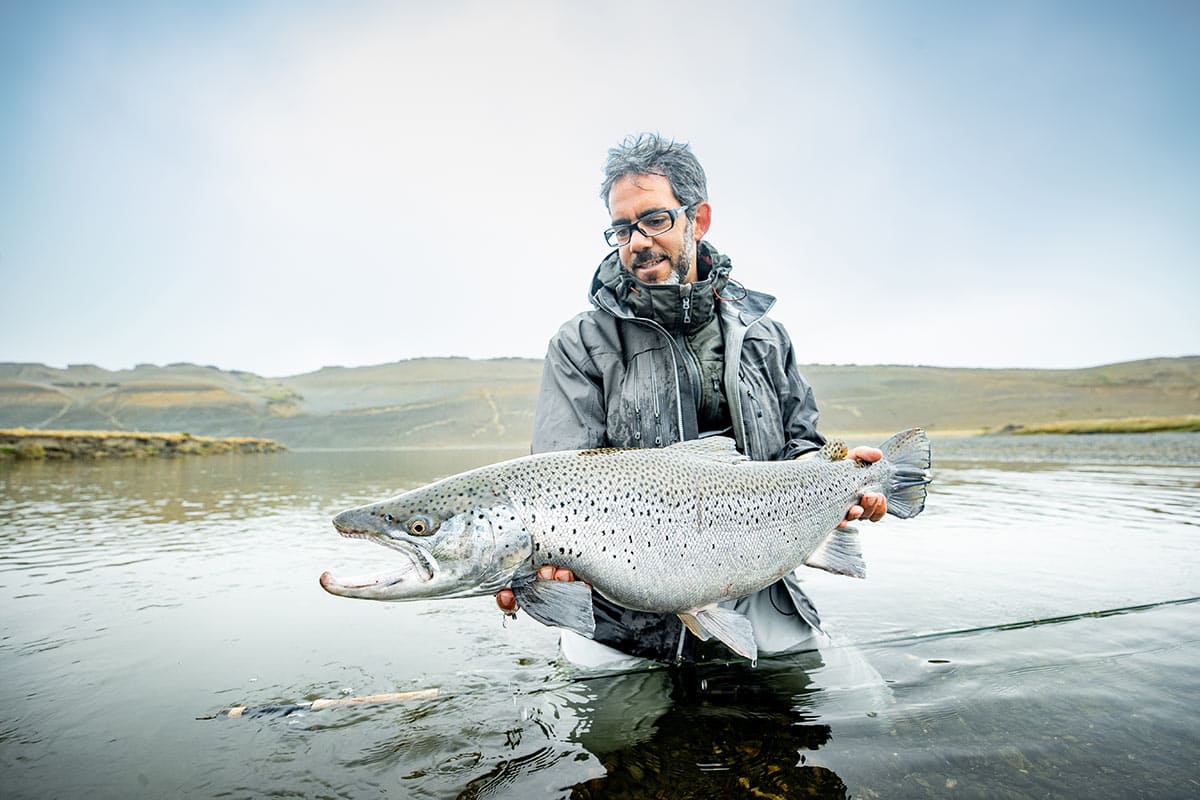
Villa María Lodge sits along the lower Río Grande in Tierra del Fuego, a section of river known for producing some of the largest sea-run brown trout anywhere in the world. With exclusive access to roughly 20 kilometers of water, anglers have the advantage of intercepting fresh fish soon after they enter the system from the Atlantic.
The lower river’s wide channels and deep pools are well suited to spey casting for efficient coverage, though single-handed rods work equally well for those who prefer a lighter approach. The season regularly produces trout in the 8- to 15-pound range, with genuine chances at fish over 20 pounds. Days are structured around two fishing sessions, taking advantage of prime low-light windows in the morning and evening, and guided by a small, experienced team that knows the beats in detail.
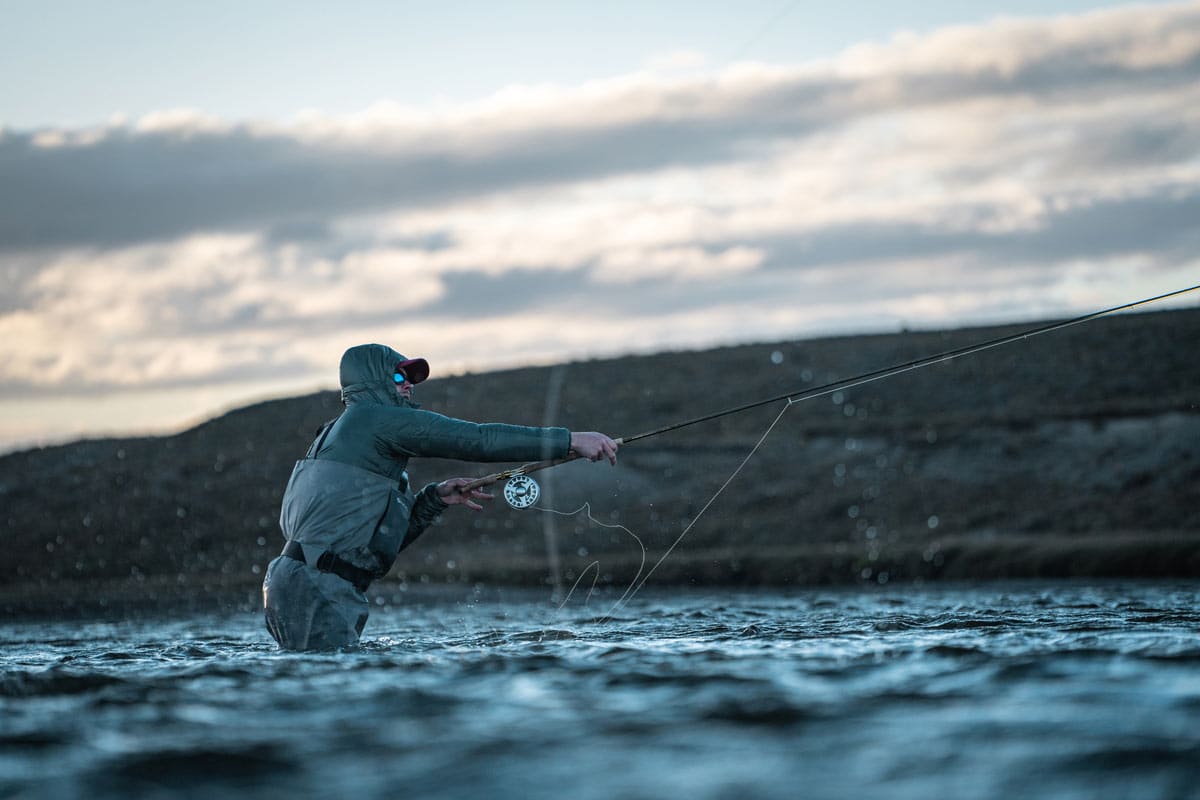
Accommodating only 6 guests at a time, Villa María offers a quiet, focused base for serious fishing. Between sessions, anglers can pause at a riverside day lodge for a hot lunch and a break before returning to the water. Evenings are spent at the main lodge, set against sweeping Patagonian landscapes, where guests can relax in shared spaces, enjoy regional cuisine, and exchange stories from the river.
The combination of productive water, low guest numbers, and access to this unique stretch of the Río Grande makes Villa María a strong choice for fly fishermen interested in a dedicated sea-run brown trout trip in one of the southernmost fishing destinations on earth.
Ready to experience South America’s most exceptional angling adventures? Explore our curated collection of premier South American fishing lodges.
About This Article: FishingExplora’s journal content is written by our in-house editorial team. Passionate about fishing and travel, we focus on producing informed, experience-driven articles that support anglers exploring top-tier angling destinations worldwide. Meet the author.
Latest Journal Posts
No results available
Journal Categories
Latest Fishing Lodges
No results available
Premium Fishing Lodges
